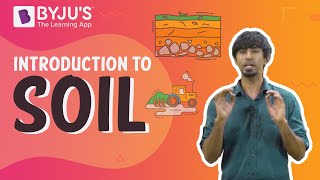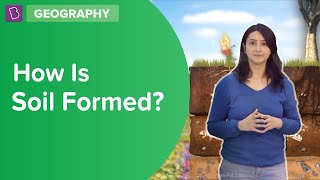All soils include substances that are dangerous or toxic to humans and other living things. However, the concentrations of such compounds in unpolluted soil are so low that they pose no damage to the environment. The soil is said to be polluted when the concentration of one or more harmful compounds is high enough to harm living creatures.
|
Definition: Soil pollution is defined as the presence of hazardous compounds (pollutants or contaminants) in soil at levels high enough to endanger human health or the environment. |
Soil Pollution Chemistry Questions with Solutions
Q-1: Which of the following is not a significant contaminant that pollutes soil?
- Polycyclic Aromatic Hydrocarbons
- Pesticides
- Dioxins
- Oxides of Nitrogen
Answer: d) Oxides of Nitrogen
Explanation: Nitrogen oxides like nitric oxide and nitrogen dioxide are major contributors of air pollution.
Heavy metals (As,Sb), PAHs, industrial waste (dioxins, plasticizers, PCBs), hydrocarbons, pesticides, insecticides and other pollutants contribute significantly to soil pollution.
Q-2: What is the connection between PAHs and soil pollution?
Answer:
PAHs (polycyclic aromatic hydrocarbons) are organic molecules that include: Naphthalene, anthracene, and phenalene are all examples of PAHs. Polycyclic aromatic hydrocarbon exposure has been associated with a variety of cancers. In humans, these chemical substances can induce cardiovascular disorders.Coke (coal) processing, automobile emissions, cigarette smoke, and shale oil extraction are all sources of PAHs in the soil.
Q-3: Which of these pollutants is an insecticide?
- Pyrethrum
- Aliphatic acids
- Thiocarbamates
- Amides
Answer: a) Pyrethrum
Explanation: Insecticides are the chemicals used to kill insects. Such chemicals include organophosphates, pyrethrum, chlorinated hydrocarbons etc.
Q-4: What role does green chemistry play in reducing pollution?
Answer: Green chemistry is a way of thinking about using existing chemistry and other science knowledge and ideas to lessen the negative influence on the environment. Green chemistry is a manufacturing method that produces minimal pollution or harm to the environment.
In a word, green chemistry is a cost-effective technique that entails lowering material, energy, and waste creation.
For example: Dry cleaning solvent tetrachloroethylene was previously utilised. The chemical is a potential carcinogen that contaminates groundwater. The technique that employed this substance has now been superseded by one that uses liquid carbon dioxide and a suitable detergent.
Q-5: What is the definition of negative soil pollution?
Answer: Negative soil contamination occurs when soil productivity is reduced as a result of erosion and misuse.
Landfilling and lost production are two examples.
Q-6: How can soil mercury toxicity influence human health?
Answer: Mercury poisoning is a toxicity caused by mercury ingestion. Mercury is a hazardous metal that can be found in various forms in the environment.Mercury is a naturally occurring element, although its levels in the environment have increased as a result of industrialization. The metal can contaminate soil and water, eventually affecting creatures such as fish, human beings.
Human beings are affected in the following ways:
- Speech difficulties
- Tremors
- Coordination and balance problems
- Headaches
- Brain, lung and kidney damage
- Memory problems
- Irritability
Q-7: What measures can be taken to prevent soil pollution?
Answer: The following measures can be used to reduce soil pollution:
1. We can prevent soil pollution by lowering our use of plastics.
2. We can reduce soil pollution by limiting the use of chemical fertilisers and pesticides.
3. Before being disposed of, industrial toxic waste should be treated to lessen its toxicity.
4. Purchasing organic items encourages the production of additional organic products. This will aid in soil contamination prevention.
5. Avoiding deforestation and environmental impact.
Q-8: Fill in the blanks
(a) Soil erosion in the desert occurs through____________.
(b) ____________ occurs as a deposit in riverbeds.
(c) ___________ should be banned to prevent soil pollution.
(d) The mixture of rock particles and humus is called____________.
(e) Percolation rate of water is highest in the _______soil and lowest in the _______soil.
Answer:
- Wind
- Silt
- Plastics
- Soil
- Sandy,clayey
Q-9: Make a list of soil pollution sources.
Answer: Soil pollution is caused due to agricultural, industrial activities(E-waste disposal), acid rain, accidental oil spills etc.The most common sources of soil pollution are:
- Effluent and sewage
- Fertilisers and chemical pesticides
- Radioactive wastes
- Lead and mercury
- Industrial wastes
- Hydrocarbons
Q-10: How is soil characterised according to particle size proportions?
Answer: The proportion of particles of various sizes is used to classify the soil. The term “sandy soil” refers to soil with a higher proportion of large particles. Clayey soil has a larger proportion of fine particles. Loamy soil has roughly equal amounts of big and small particles. As a result, the soil is categorised as sandy, clayey, or loamy.
Q-11: Define the following terms:
- Soil profile
- Humus
- Weathering
Answer:
- Soil profile: The soil profile is a vertical section across several strata of soil. Each layer has its own texture, colour, depth, and chemical makeup. Horizons are the names given to these levels.
- Humus: The organic component of soil generated by soil microbes decomposing leaves and other plant material is called humus. In short it is the rotting dead matter in the soil.
- Weathering: The action of wind, water, and climate breaks down rocks, resulting in soil formation. Weathering is the term for this process.The nature of any soil depends upon the rocks from which it has been formed and the type of vegetation that grows in it
Q-12: Why is it a cause for concern when there are pieces of plastic products and polythene bags in the soil?
Answer: Plastics and polythene bags contaminate the earth. They also eliminate soil-dwelling creatures. As a result, there is a push to ban polythene bags and plastics. Waste materials, chemicals, and pesticides are among the other pollutants that damage the soil.
Before being released into the soil, waste products and chemicals should be handled. Pesticides should be used sparingly.
Q-13: Which of the following is the correct characteristic of organic toxins?
- Non- biodegradable
- Insoluble
- Both of the above
- Soluble
Answer: c) Both of the above
Explanation: Toxic compounds generated from living creatures are known as organic toxins. In most cases, they are insoluble and non-biodegradable. They are just as dangerous to humans as manufactured chemicals.
Example: Aldrene, toxaphene
Q-14: The soil pollutant methylbenzene is
- Inorganic pollutant
- Carcinogenic organic pollutant
- A herbicide
- None of the above
Answer: b) Carcinogenic organic pollutant
Q-15: Why are epiphytic lichens used as a pollution indicator?
Answer:
Lichens are the result of a symbiotic relationship between fungi and algae. Epiphytic lichens get practically all of their nutrients from the atmosphere through uptake across their whole surface. Lichens are therefore highly susceptible to changes in atmospheric composition. Sulphur, nitrogen, acidity, halogens (e.g., fluoride), heavy metals, and ozone are all toxic to lichens.As a result, they will not grow in contaminated places and will only thrive in non-polluted locations. Hence,lichens are pollutants or pollution indicators.
Practise Questions on Soil Pollution
Q-1: Which type of soil would be the best for growing plants?
- Loam
- Clay
- Sand
- None of the above
Q-2: What is soil erosion? Make recommendations for how to avoid it.
Q-3: High concentration of benzene in the soil causes
- Leukaemia
- Ischemic heart disease
- Stroke
- COPD
Q-4: What is anthropogenic soil pollution?
Q-5: Which of the following is not correct about clayey soil?
- Good water holding capacity
- Suitable for the growth of paddy
- Light in weight
- Rich in organic matter
Click the PDF to check the answers for Practice Questions.
Download PDF
Recommended Videos
Introduction to Soil

How Is Soil Formed?

Comments